Mosquito fish - Gambusia affinis
Scientific name: Gambusia affinis
Common name: Mosquito fish
Family: Poeciliidae
Usual size in fish tanks: 4 - 7 cm (1.57 - 2.76 inch)
014
Recommended pH range: 6.8 - 8
Recommended water hardness: 4 - 19°N (71.43 - 339.29ppm)
0°C 32°F30°C 86°F
Recommended temperature range: 21 - 26 °C (69.8 - 78.8°F)
The way how these fish reproduce: Pseudo-Livebearer
Where the species comes from: North America
Temperament to its own species: peaceful
Temperament toward other fish species: aggressive to smaller
Usual place in the tank: Middle levels
General Information
The western mosquitofish (Gambusia affinis) is a small livebearing poeciliid native to North America—the Mississippi River basin and Gulf-slope drainages from the U.S. Gulf Coast south-west to Tampico, Mexico. It has been introduced worldwide for mosquito control, often with harmful ecological effects. Females reach up to ~7 cm TL; males ~4–5 cm TL.
Food & Feeding
Omnivorous micro-predator: takes insect larvae (including mosquitoes), small crustaceans, worms, and grazes biofilm/algae. In aquaria use quality flakes or micro-pellets as staple and rotate frozen/live daphnia, brine shrimp, cyclops, bloodworms (in moderation). Provide some plant matter (spirulina) and feed small portions 1–2× daily.
Sexing
Males are smaller and possess a gonopodium (modified anal fin); females are larger and often show a gravid spot.
Breeding
True livebearer (viviparous), not a “pseudo-livebearer.” Females can store sperm and exhibit superfetation. Gestation is typically ~16–28 days depending on temperature; broods commonly number 20–60 fry. Adults may predate fry—dense plants/mops improve survival.
Lifespan
Usually ~1–2 years in the wild; up to ~3 years reported in captivity with excellent care.
Tank Requirements & Water Parameters
- Footprint & cover: active surface-oriented fish; provide open surface lanes with floating cover and plants.
- Water: very tolerant; aim for pH 6.8–8.0, hardness moderate–hard, temperature 21–26 °C in home aquaria (species tolerates cooler/warmer outdoors but stability matters).
- Filtration: moderate flow, high oxygenation; they handle light brackish conditions as well.
Compatibility & Tank Mates
Not community-friendly despite size. Mosquitofish are notorious fin-nippers with intraspecific aggression (especially males). Keep either single-sex groups with space and cover, or avoid mixing with delicate/slow tank mates. Do not house with tiny or long-finned species.
Behaviour & Usual Place in the Tank
Surface to upper-middle levels: they patrol the topwater, darting for prey and oxygen-rich zones; drop lower when threatened. Labeling them strictly “middle” is inaccurate.
Conservation & Legal/Release Note
Introduced populations often harm native fishes and amphibians; many regions regulate their release/stocking. Never release aquarium fish to the wild.
Short Description
Gambusia affinis is a hardy, surface-dwelling North American livebearer that breeds readily and tolerates a wide range of conditions—but its aggression and invasive potential make it a poor choice for community tanks and a species that should be kept responsibly.
Q&A
- Native where? U.S. Mississippi basin and Gulf-slope drainages to Tampico, Mexico (North America).
- How big? Females up to ~7 cm TL; males ~4–5 cm TL.
- Reproduction type? Livebearer with ~16–28 day gestation; broods often 20–60 .
- Community safe? Generally no—fin-nipping and conspecific bullying are common.
Pictures
Bought by aqua-fish.net from jjphoto.dk.
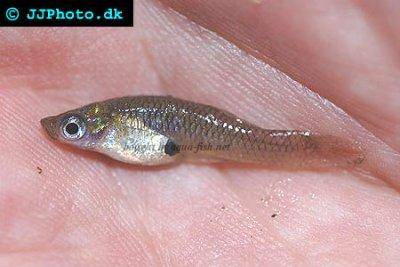



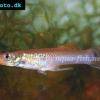 Pike
Pike 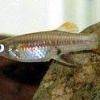 Biskop-tandkarpe
Biskop-tandkarpe 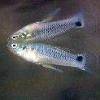 Twospot
Twospot 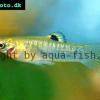 South
South 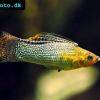 Sailfin
Sailfin 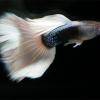 Guppy
Guppy  Short
Short 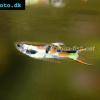 Endler’s
Endler’s 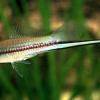 Swordtail
Swordtail 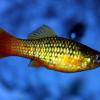 Platy
Platy 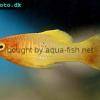 Variegated
Variegated